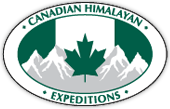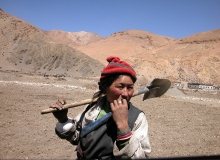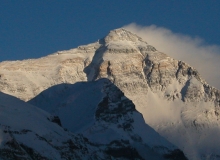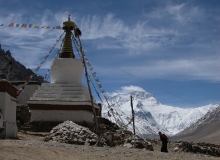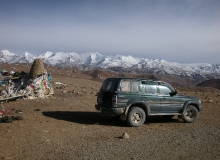Best of Tibet with Mt. Everest
Map
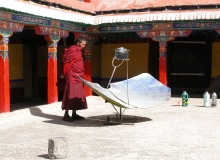 This is the classic overland route between two very exotic Asian cities. From the vast and barren beauty of the Tibetan Plateau to the lush hills of Nepal, you are treated to special insight into Tibetan and Buddhist culture. This trip is a great add-on to our Nepal adventures. Three days are spent around Lhasa exploring the ancient monasteries and palaces in the area: Potala, Drepung, Sera, Jokhang and the Summer Palace. The overland journey includes visits to a number of monasteries (Palkhor, Tashilhunpo), and crosses numerous high-altitude passes, including the 17,200 foot Jia Tsuo La. You can join a group trip, or form your own. As long as there are three or more participants, we can run this as a private trip in 4WD Land Cruisers for about $200us more per person.
This is the classic overland route between two very exotic Asian cities. From the vast and barren beauty of the Tibetan Plateau to the lush hills of Nepal, you are treated to special insight into Tibetan and Buddhist culture. This trip is a great add-on to our Nepal adventures. Three days are spent around Lhasa exploring the ancient monasteries and palaces in the area: Potala, Drepung, Sera, Jokhang and the Summer Palace. The overland journey includes visits to a number of monasteries (Palkhor, Tashilhunpo), and crosses numerous high-altitude passes, including the 17,200 foot Jia Tsuo La. You can join a group trip, or form your own. As long as there are three or more participants, we can run this as a private trip in 4WD Land Cruisers for about $200us more per person.
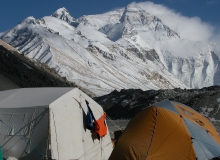 Shortly after leaving Shegar, we head south over the Pang La (5,150 m) towards the main Himalayan range. The view from the top is incredible with uninterrupted views stretching from Makalu to Shishapangma. Below the pass, Everest initially is hidden from view, but as we turn the corner into the Rongbuk Valley it reappears, more impressive than ever.
Shortly after leaving Shegar, we head south over the Pang La (5,150 m) towards the main Himalayan range. The view from the top is incredible with uninterrupted views stretching from Makalu to Shishapangma. Below the pass, Everest initially is hidden from view, but as we turn the corner into the Rongbuk Valley it reappears, more impressive than ever.
Detailed Itinerary
(Thursday) ARRIVE KATHMANDU (1,280 meters / 4,200 feet)
1
(Friday) KATHMANDU (1,280 meters / 4,200 feet)
2
(Saturday) LHASA (3,650 meters / 11,975 feet)
FLIGHT TO LHASA: Probably the most spectacular flight in the world! Leaving Kathmandu the plane skirts the Himalayan range where Cho Oyo (8,153 m), Lhotse (8,501 m), Everest (8,848 m) and Makalu (8,463 m) are visible. Looking back as the plane leaves Kathmandu it may be possible to also see Manaslu (8,125 m) and Annapurna I (8,091 m). Turning North the plane crosses between Kanchenjunga (8,586 m) and Makalu. From the left side of the plane the east face of Everest and Makalu are visible and from the right the whole Kanchenjunga massive and Chomo Lhari in Bhutan (7,315 m). The flight is a spectacular experience to see eight of the world’s fourteen 8,000 m peaks. The flight duration will be about one hour.
ARRIVAL AT THE GONGAR AIRPORT LHASA (3,650 meters / 11,975 feet)Completion of airport formalities and transfer to a comfortable hotel. It is a two hour drive and we should arrive at the hotel about 4 P. M. local time (there is a 2 hour & 15 minute time change – later than Nepal). Rooms are assigned, and the Lhasa program will be outlined by your guide.
This evening you are free to relax and explore. Visit the Barkhor Plaza, an excellent place to walk around, and have dinner.
3
(Sunday / Monday) LHASA (3,650 meters / 11,975 feet)
The POTALA PALACE (now a museum, but still visited by Tibetan pilgrims as a holy site). Former winter residence of the Dalai Lama and named after Mt. Potala in India, one of the holy mountains of the Hindu God Lord Shiva. The Potala is a place of spiritual pilgrimage and a mammoth tribute to Tibetan architectural skills. Built by the fifth Dalai Lama in 1645, the Potala was from then on the winter residence of all Dalai Lamas and is still occupied today by monks.
The BARKHOR PLAZA (in front of Jokhang Temple) This is Lhasa’s inner pilgrim circuit, shaped roughly like an octagon, which runs around the Jokhang. The market place has everything a Tibetan pilgrim would need and is a good place for people watching. Tibetan pilgrims spin prayer wheels and prostrate themselves they circumnavigate the Temple. Good for shopping - — everything from trinkets to Tibetan carpets and paintings.
JOKHANG TEMPLE - in the heart of old Lhasa, and the most sacred temple in Tibet — established in 7th century by King Songtsen Gampo, the King who brought Buddhism to Tibet. One can see the statue of Buddha (Jowo Shakyamuni) brought by the Chinese wife of the King as part of her wedding dowry. King Songtsen Gampo also had a Nepalese wife who was the force behind the use of Nepalese craftsmen in designing the Jokhang.
NORBULINKA - The summer palace of the Dalai Lamas was started by the Seventh Dalai Lama in 1755. This large complex of small palaces and chapels within a walled garden and is about four kms west of the Potala.
SERA MONASTERY - founded in 1419, located on the outskirts of Lhasa - principle buildings are intact — Home of the Gelukpa Order - yellow hat sect — the Dalai Lama’s sect. Sera was at one time famous for its fighting monks, who spent years perfecting the martial arts. Here, as at Drepung, many monks renounced their vows to take up arms during the uprising of 1959.
DREPUNG MONASTERY - founded in 1416, on the outskirts of Lhasa — at one time the largest of the Gelukpa Monasteries (10,000 monks) — was a major center of religious power. The Ganden Potang (ganden palace) was built by the second Dalai Lama and was used as a residence for the Third, Fourth and Fifty Dalai Lama. The remains of the second, third and fourth Dalai Lama are here. Just below Drepung lies the Nechung Monastery, which was once the seat of the Oracle of Tibet.
TIBETAN MEDICINE CLINIC - A tour of this establishment is highly recommended. An English speaking Tibetan medical doctor will give you short history of Tibetan medicine, an interesting tour of the clinic, and show you a small Tibetan museum complete with medical Thangkas. Hopefully there will be a chance for this visit. Try to arrange this through your local guide.
4-5
(Tuesday) LHASA TO GYANTSE (3 ,950 metres / 12,956 feet) (261 kms / 163 miles)
GYANTSE - It is a small town on the northern bank of the Nyang Chu River. During the 15th century it was the capital of a small kingdom. Towering over Gyantse on a steep hill are the ruins of an old and famous fort. It was here in 1904, that the British expedition led by Younghusband defeated an army of 5,000 Tibetans with superior gunpower. Gyantse is very Tibetan in feel and style — it has not suffered from modern expansion. There are many shops, and simple restaurants where you can easily get Tibetan food such as Momos (dumpling), Chang (millet beer) and Thukpa (noodles).
Highlights include the KUMBUM TEMPLE (founded in 1440) , and the PELKOR CHODE (central monastic building - started in 1418). This is possibly the most beautiful temple in Tibet. It was constructed in the 15th century by Newar artisans and is the best preserved example of Newari art to survive in Tibet . It has 112 Chapels. Remember to circumambulate clockwise. Many of the original statues remain intact.
6
(Wednesday) GYANTSE TO SHIGATSE (3,900 metres / 12,870 feet) (60 kms, a pleasant 2 hour drive.)
TASHILUMPO MONASTERY - Founded in 1447, it is the historical seat of the Panchen Lama (the traditional teacher of the Dalai Lama). Among the many interesting sights are the 26 meter high statue of the future Buddha which is gilded with gold and decorated with valuable jewels. The main monastery is the largest and contains prayer halls, printing blocks, and statues of many deities. It is not uncommon to see monks and lamas studying and debating nearby.
Afterwards it is pleasant to walk around the old part of town & visit the market where a variety of goods are available. This is also a good place to replenish you snack supply if it is running low. Avoid browsing if not shopping. When shopping remember to bargain (for instance offer half the asking price and then haggle from there).
7
(Thursday) SHIGATSE TO SHEGAR (4,350 metres / 14,272 feet) ( 244 kms / 153 miles)
Enroute from Shigatse we turn off the main road to visit Sakya Monastery. The visit there takes about 3 hours depending on the road conditions (which are not very good in the July–August season when there is usually more rain).
SAKYA MONASTERY - founded in 1073 by a sect of Tibetan Buddhism supported by the Mongolians. This sect does not rely on the recognition of incarnate lamas as spiritual leaders. Rather it is based on a hierarchy of hereditary - from father to son. There is also a celibate order that is subordinate to the hereditary system. It is one of the oldest and most important Bon Po monasteries in the region. At one time it housed over 500 monks. Today, little remains of the northern monastery, but there is still lots to see in southern monastery complex. After visiting Sakya, you will continue on towards Shegar.
SHEGAR - Shegar was once the provincial capital of the Tingri area and is now a regional administrative center. This is the highest overnight spot on the trip and sleeping could be difficult due to the high altitude. Be sure to drink lots of fluids and try to eat even if you do not feel very hungry.
8
(Friday) SHEGAR TO RONGBUK (5,000 metres) (68 kms / 42 miles)
9
(Saturday) RONGBUK TO TINGRI (4,390 metres) (65 kms / 40 miles)
After lunch, we return to the Friendship Highway and drive to Tingri where we will stay overnight.
10
(Sunday) TINGRI TO ZHANGMU (2,300 metres) (181kms / 113 miles)
11
(Monday) ZHANGMU TO KATHMANDU (1280 metres / 4200 feet) (117 kms / 73 miles)
Arriving at the FRIENDSHIP BRIDGE (Nepal - Tibet border) you will cross back into Nepal. Remember to turn your watches back 2 hrs 15 min. You will be met by our agent at the bridge. Bags will be loaded onto a mini bus by porters provided by our agent, and you will then proceed to Nepal Customs and the Immigration inspection. If there is a landslide blocking the road, porters will be provided to carry your bags to the check post.
Re-enter Nepal: You should either have already arranged a double entry Nepal visa ($55 US for 60 days double entries available upon arrival at Kathmandu airport ), or you will have to get another visa at the border post. It is quite simple, but make sure you have the $30 US and a passport sized photo of yourself, or you may have some difficulty with procedures.
The drive from Friendship Bridge to Kathmandu is approximately 5 hrs under normal conditions, the first hour through a deep and verdant river valley… and you should arrive back in Kathmandu around 4 P.M. Tonight we will stay at the Kathmandu Guest House.
12
(Tuesday) Trip ends
13
PLEASE NOTE: We can arrange to link this trip up with one of our Nepal or India treks, or with a customized Nepal or India tour.
Synopsis
Trip Grading:

Length: 13 days
Max. Altitude: 18,400ft / 5600m
Begins/Ends in Kathmandu
Land Cost: $2655 (Kathmandu-Lhasa airfare: $540)
International Airfare: Apx. $1800 to Kathmandu (from North America)
Departs any day April to November
Single supplement: $480
Included in the land cost: Accommodations on twin sharing basis with best available hotels enroute. 4 wheel drive Toyota Land cruiser (maximum 4 people in one ). English speaking Tibetan Guide, monastery entrance fees, mountain entrance fees.
Cost does not Include: Cost does not include: Nepal visa ($40 USD multiple entry), China/Tibet Visa Processing Fee US$ 85 (for all nationalities except USA passport holders. USA passport holders is $175) if required. Rules and regulations for travel to Tibet are subject change on short notice, please contact our office for up to date information. Travel Insurance, Evacuation cost, extra cost in the event of landslide for hiring porters or arranging additional transportation and expenses of personal nature etc.
You can also contact Canadian Himalayan Expeditions directly for more information.
Synopsis
Trip Grading:

Length: 13 days
Max. Altitude: 18,400ft / 5600m
Begins/Ends in Kathmandu
Land Cost: $2655 (Kathmandu-Lhasa airfare: $540)
International Airfare: Apx. $1800 to Kathmandu (from North America)
Departs any day April to November
Single supplement: $480
Included in the land cost: Accommodations on twin sharing basis with best available hotels enroute. 4 wheel drive Toyota Land cruiser (maximum 4 people in one ). English speaking Tibetan Guide, monastery entrance fees, mountain entrance fees.
Cost does not Include: Cost does not include: Nepal visa ($40 USD multiple entry), China/Tibet Visa Processing Fee US$ 85 (for all nationalities except USA passport holders. USA passport holders is $175) if required. Rules and regulations for travel to Tibet are subject change on short notice, please contact our office for up to date information. Travel Insurance, Evacuation cost, extra cost in the event of landslide for hiring porters or arranging additional transportation and expenses of personal nature etc.
You can also contact Canadian Himalayan Expeditions directly for more information.
